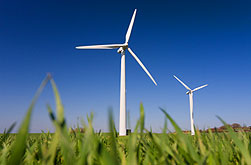Wind Turbines
- Wind Turbines
- Wind Turbines FAQ
 Commercial Energy Saving Checklist.pdf
Commercial Energy Saving Checklist.pdf
 The ideal site for small wind generators is a flat hilltop with clear exposure, free from excessive turbulence
caused by obstructions such as large trees, houses or other buildings. Wind speed increases with height so if
there are local physical obstructions, it is advisable to mount the small wind generator on a mast or tower.
The ideal site for small wind generators is a flat hilltop with clear exposure, free from excessive turbulence
caused by obstructions such as large trees, houses or other buildings. Wind speed increases with height so if
there are local physical obstructions, it is advisable to mount the small wind generator on a mast or tower.Small Wind Turbines - Wind Speed Assessment
Have a good working knowledge of the wind speed at the site. The Energy Saving Trust website provides a wind speed predictor that gives estimates of the annual mean wind speeds throughout the UK. It is also essential to install monitoring equipment to assess the wind speed on the proposed site for at least three months, and preferably longer. A successful installation will require an annual mean wind speed of 5 metres per second.
Household Electricity Demand
An average house uses an estimated 4,700 kilowatt hours (kWh) of electricity per year.
Types of Small Wind Turbines
Small wind turbines vary in size and power output from a few hundred watts to two or three megawatts but a typical domestic system would be between 1 and 6 kilowatts. There are two types of electrical installation:
- Roof Mounted Small Wind Turbines
Care must be taken when choosing a small wind turbine that is mounted on the roof of a home. The small wind turbine may not be high enough to stand clear of the obstructions that cause drag or turbulence and there are also potential problems of noise and vibration that must be addressed.
In the Energy Saving Trust field trials, the building mounted small wind generators monitored were primarily located in urban and suburban locations that were found to have inadequate wind speeds. The poor location of these turbines has significantly impacted on the measured performance of such generators. - Mast Mounted Small Wind Turbines
Mast mounted small wind turbines are free standing and can often be located near the building that will use the electricity. If there are a lot of obstructions within 200m of the proposed turbine location, then a mast or tower should be considered. Generally, the higher the mast, the higher the average wind speed that the small wind turbine will achieve. It is usually the case in UK conditions that a taller mast will help generate enough extra energy to justify its additional cost.
Small wind turbines are particularly suitable for remote off-grid locations where conventional methods of supply are expensive and impractical. Most small wind turbine systems generate direct current (DC) electricity and, in stand alone systems, this is fed into battery storage.
Mains Small Wind Turbines
Small wind turbines can also be connected to the local electricity supply network. An inverter transforms direct current (DC) electricity to alternating current (AC) at an acceptable quality and standard. No battery storage is required and any unused or surplus electricity can be exported to the local electricity supply network, via an approved import/export meter, and will be paid for by the nominated electricity supply company.
Typical Output of Small Wind Turbines
- A 1.5kw small wind turbine can produce an average 3,942 kWh per year, saving 3,390 kg of CO2 emissions a year.
- A 5kw small wind turbine can produce 13,140 kWh per year, saving 11,300 kg of CO2 emissions each year.
- A 15kW small wind turbine can produce 39,420 kWh per year, saving 33,900 kg of CO2 emissions each year.
The BWEA Standard has devised a technical standard for manufacturers of small wind generators who wish to supply in the British market place.
small wind turbine that meets this standard, a user can be assured that the turbine has been designed to withstand the structural loads that the wind can impose, that it has been tested in a full range of wind speeds and that in general it meets the claims made for overall performance.
It is useful for grant giving bodies, structural engineers and green energy specifiers who wish to ensure that any small wind turbines proposed is designed to the best practices accepted in wind energy engineering.
Typical Cost of Small Wind Turbine
The price of a small wind system depends on the size and type of turbine. The Government's Clear Skies grants programme estimates that a typical small wind system costs £2,500 - £5,000 per kw capacity installed.
Planning Permission for Small Wind Turbines
Small wind turbine systems require consultation with neighbours and planning permission. Environmental issues will be the main influencing factors; principally, noise, visual impact and access to the site. National planning policies support the development of small scale wind energy. Applications for small scale developments can be approved in areas such as National Parks, Areas of Outstanding Natural Beauty and Heritage Coasts, provided there are no serious environmental factors that will be detrimental to the area concerned.
Before embarking on a small wind turbine system, it is advisable to improve the energy efficiency of your house through improved insulation, draught proofing, low energy lights and heating controls.











